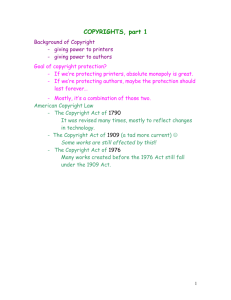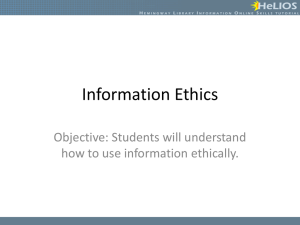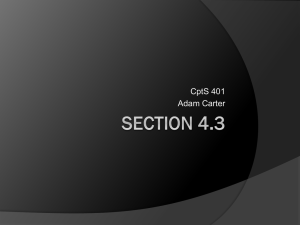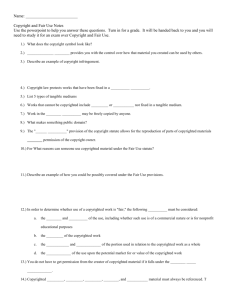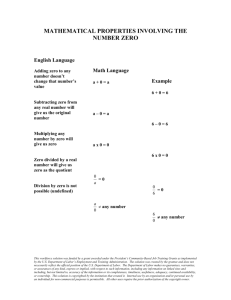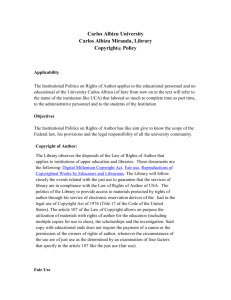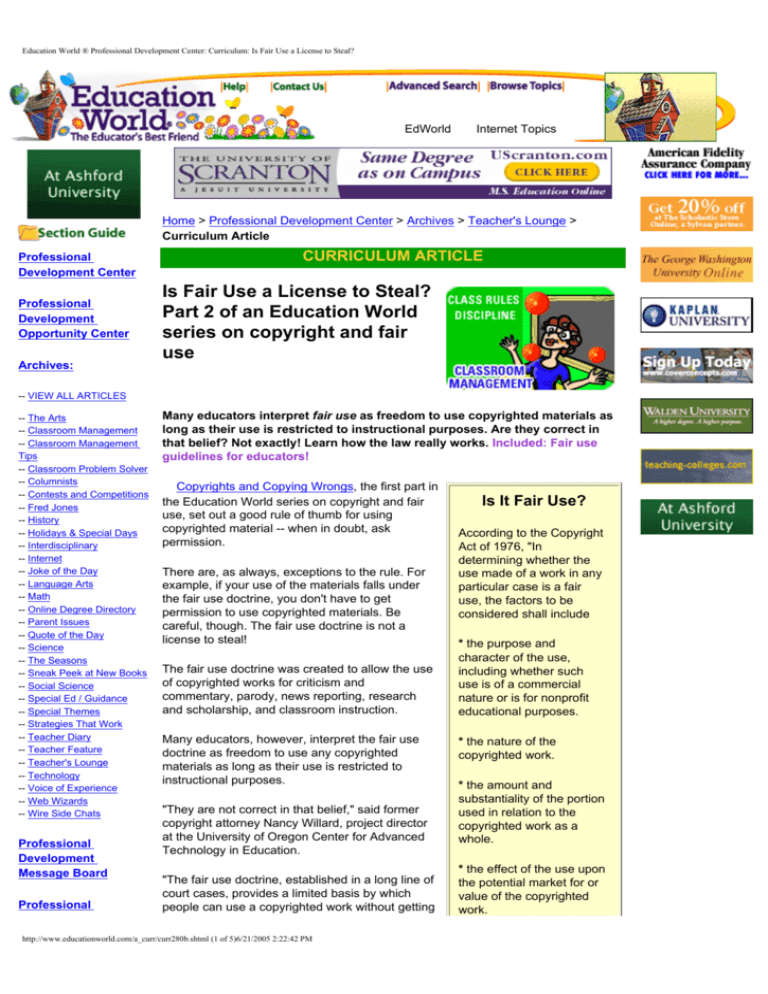
Education World ® Professional Development Center: Curriculum: Is Fair Use a License to Steal?
EdWorld
Internet Topics
Home > Professional Development Center > Archives > Teacher's Lounge >
Curriculum Article
Professional
Development Center
Professional
Development
Opportunity Center
Archives:
CURRICULUM ARTICLE
Is Fair Use a License to Steal?
Part 2 of an Education World
series on copyright and fair
use
-- VIEW ALL ARTICLES
-- The Arts
-- Classroom Management
-- Classroom Management
Tips
-- Classroom Problem Solver
-- Columnists
-- Contests and Competitions
-- Fred Jones
-- History
-- Holidays & Special Days
-- Interdisciplinary
-- Internet
-- Joke of the Day
-- Language Arts
-- Math
-- Online Degree Directory
-- Parent Issues
-- Quote of the Day
-- Science
-- The Seasons
-- Sneak Peek at New Books
-- Social Science
-- Special Ed / Guidance
-- Special Themes
-- Strategies That Work
-- Teacher Diary
-- Teacher Feature
-- Teacher's Lounge
-- Technology
-- Voice of Experience
-- Web Wizards
-- Wire Side Chats
Professional
Development
Message Board
Professional
Many educators interpret fair use as freedom to use copyrighted materials as
long as their use is restricted to instructional purposes. Are they correct in
that belief? Not exactly! Learn how the law really works. Included: Fair use
guidelines for educators!
Copyrights and Copying Wrongs, the first part in
the Education World series on copyright and fair
use, set out a good rule of thumb for using
copyrighted material -- when in doubt, ask
permission.
There are, as always, exceptions to the rule. For
example, if your use of the materials falls under
the fair use doctrine, you don't have to get
permission to use copyrighted materials. Be
careful, though. The fair use doctrine is not a
license to steal!
The fair use doctrine was created to allow the use
of copyrighted works for criticism and
commentary, parody, news reporting, research
and scholarship, and classroom instruction.
Many educators, however, interpret the fair use
doctrine as freedom to use any copyrighted
materials as long as their use is restricted to
instructional purposes.
"They are not correct in that belief," said former
copyright attorney Nancy Willard, project director
at the University of Oregon Center for Advanced
Technology in Education.
"The fair use doctrine, established in a long line of
court cases, provides a limited basis by which
people can use a copyrighted work without getting
http://www.educationworld.com/a_curr/curr280b.shtml (1 of 5)6/21/2005 2:22:42 PM
Is It Fair Use?
According to the Copyright
Act of 1976, "In
determining whether the
use made of a work in any
particular case is a fair
use, the factors to be
considered shall include
* the purpose and
character of the use,
including whether such
use is of a commercial
nature or is for nonprofit
educational purposes.
* the nature of the
copyrighted work.
* the amount and
substantiality of the portion
used in relation to the
copyrighted work as a
whole.
* the effect of the use upon
the potential market for or
value of the copyrighted
work.
Education World ® Professional Development Center: Curriculum: Is Fair Use a License to Steal?
Development
Resources
permission from the creator," Willard told
Education World. "The essence of the fair use
doctrine is that a person is not using the work in
such a manner that is, or has the potential of, diverting income from the creator."
Administrators
Lesson Planning
Professional
Development
School Issues
Site Reviews
Special Themes
Teacher Lessons
Tech in Classroom
IS IT FAIR USE?
"To determine whether a use is fair requires consideration of four factors," Willard
added. "The first factor is the purpose of the copying, and copying to support an
educational use certainly meets this standard. There are three other factors, though:
how much has been copied, what kind of material has been copied, and the
potential financial loss to the creator. So, although your heart and intentions may be
pure, the other factors must still be considered."
Those factors, codified in Section 107 of the Copyright Act of 1976, are
The Arts
Foreign Languages
History
Language, Literature
Math
PE and Health
Science
Social Sciences
Technology
Counseling
Early Childhood
Higher Ed
Preservice Ed
Special Ed
Vocational Ed
Add A Site
"Best Of" Series
Careers
Contests/ Competitions
Ed Standards
Grants Center
Holidays
Message Boards
Newsletters
Parents
Prof Development
School Issues Glossary
Students
Quick Research
World Resources
School Directory
Fundraising
E-Learning
Prof Dev Oppty Center
School Funding Center
Fundraising
Ed World History
Sponsorship
About Our Fellows
Advertisers
Leading Fellows of Ed
1. the purpose and character of the use, including whether such use is of a
commercial nature or is for nonprofit educational purposes.
2. the nature of the copyrighted work.
3. the amount and substantiality of the portion used in relation to the
copyrighted work as a whole.
4. the effect of the use upon the potential market for or value of the copyrighted
work.
When evaluating a particular use of copyrighted materials in relation to those four
factors, you should ask yourself the following questions regarding
1. the purpose and character of the use:
● Does the new work transform the original work or offer something
beyond the original? Copyrighted works that are altered significantly
are more likely to be considered fair use.
● Is the use for nonprofit or educational purposes? Copyrighted works
used for nonprofit or educational purposes are more likely to be
considered fair use.
2. the nature of the copyrighted work:
● Is the copyrighted work published or unpublished? Published works
are more likely to be considered fair use.
● Is the original work out of print? Out of print works are more likely to
be considered fair use.
● Is the copyrighted work factual or creative? Factual works are more
likely to be considered fair use.
3. the amount and substantiality of the portion used in relation to the
copyrighted work as a whole:
● Is the amount of the original work used reasonable? The smaller the
percentage of the work used, the more likely it is to qualify as fair use.
● Is the section of the original work used the most important part of the
work? The less significant the portion of the work used, the more likely
it is to be considered fair use.
Sponsored links:
Fundraisers &
Fundraising Ideas:
Earn 90% Profit!
Walden University
M.S. in Education
Degrees Online
Host Department
Web Hosting
Best Sellers
Best Websites
Marketing Questions
4. the effect of the use upon the potential market for or value of the copyrighted
work:
● Does the new work appeal to the same audience as the original work?
Copyrighted works that are used for another purpose or designed to
appeal to a different audience are more likely to be considered fair
use.
GUIDELINES FOR EDUCATORS
http://www.educationworld.com/a_curr/curr280b.shtml (2 of 5)6/21/2005 2:22:42 PM
Management Questions
Online Directory
Weight Loss Pills
Master's in Ed
The University of
Scranton Click Here.
Education World ® Professional Development Center: Curriculum: Is Fair Use a License to Steal?
Contact Us
Help
"Over the years, librarians, educators, and publishers have developed voluntary
guidelines to address fair use," Willard told Education World. "Although these
guidelines are not statutory, they are contained in the legislative history of the
Copyright Act."
Those guidelines allow educators, under most circumstances, to copy
●
●
●
●
●
a single chapter from a book
an excerpt from a work that combines language and illustrations, such as a
children's book, not exceeding two pages or 10 percent of the work,
whichever is less
a poem of 250 words or less or up to 250 words of a longer poem
an article, short story, or essay of 2,500 words or less, or excerpts of up to
1,000 words or 10 percent of a longer work, whichever is less; or
a single chart, graph, diagram, drawing, cartoon, or picture from a book,
periodical, or newspaper.
Get your Masters
in Education
degree online!
Top Stories
Latest News
Kaplan University
Master's of Arts in
Teaching & Learning
Data Recovery
Software
Hoodia Diet Pills
Hoodia Gordonii
& Diet Hoodia Pills
Payday Loans
Data Recovery Services
The guidelines do not allow users to
●
●
●
●
●
make multiple copies of different works as a substitute for the purchase of
books or periodicals
copy the same works for more than one semester, class, or course
copy the same work more than nine times in a single semester
use copyrighted work for commercial purposes
use copyrighted work without attributing the author.
MUSIC, TV, AND VIDEOTAPES
Educational technology existed, of course, -- in the form of audio and video -- long
before the Internet, software, digital images, and multimedia productions invaded
our classrooms. Guidelines for the use of such "primitive" technologies were
developed.
The guidelines developed in 1976 for the educational use of music include the
following:
●
●
●
●
●
●
●
Multiple copies of sheet music may be copied in an emergency (for an
imminent performance) to replace purchased copies that are not available,
provided purchased replacement copies are substituted as soon as possible.
For academic purposes other than performance, multiple copies of excerpts
of works may be made, provided the excerpts don't include more than 10
percent of the whole work or make up a part of the whole that would
constitute a performable unit, such as a section, a movement, or an aria. The
number of copies may not exceed one copy per student.
For academic purposes other than performance, a single copy of an entire
performable unit (section, movement, aria, etc.) may be made if the unit is
out of print or available only in a larger work.
Sheet music that has been purchased may be edited or simplified if the
fundamental character of the work is not distorted and that lyrics are not
altered or added.
A single copy of a sound recording of a student performance may be made
for evaluation or rehearsal purposes and may be retained by the educational
institution or individual teacher.
A single copy of a sound recording of copyrighted music may be made from
sound recordings owned by an educational institution or an individual teacher
for the purpose of constructing aural exercises or examinations and may be
retained by the educational institution or individual teacher.
Copying to create, replace, or substitute for anthologies, compilations, or
collective works; copying works intended to be consumable, such as
workbooks, exercises, or standardized tests; copying for the purpose of
http://www.educationworld.com/a_curr/curr280b.shtml (3 of 5)6/21/2005 2:22:42 PM
Hard Drive Data
Recovery
Ashford University
Offers top Master's
Teaching degrees
Continuing Education
Concert Tickets
Leading Trade and
Vocational Career
Schools and Courses
Education World ® Professional Development Center: Curriculum: Is Fair Use a License to Steal?
performance (except in an emergency); copying as a substitute for purchase;
and copying without the inclusion of the copyright notice are not permitted.
In 1981, a congressional subcommittee developed guidelines for off-air taping of
television and radio broadcasts for educational use. Those guidelines allow
educators to tape a radio or television broadcast for instructional (not entertainment)
use if
●
●
●
●
●
●
●
●
the program is recorded simultaneously with the broadcast.
the program is being broadcast without charge.
the program is recorded only in response to a specific request.
the program is recorded (but not necessarily used) in its entirety.
the program is not altered.
the tape is retained by the educational institution for no longer that 45 days
after the date of the recording.
the tape is used only once with each class during the first ten consecutive
school days of the 45-day retention period.
the tape is used from the tenth to the 45th day of the retention period for
teacher-evaluation purposes only.
In addition, guidelines established in 1976 allow educators who have bought or
rented videocassettes designated for home use only to use those videocassettes for
face-to-face student instruction -- but not for student entertainment.
IS PRISON IN YOUR FUTURE?
Obviously, copyright law is complicated and easily misinterpreted. Even those with
the best intentions -- and the best lawyers -- are liable to make mistakes.
The Copyright Website provides some fascinating examples of some
big names who made costly copyright errors.
So what are the chances you'll find yourself in court? Pretty slim -- although they
increase dramatically if your use of a work interferes with the owner's potential
income. Most copyright owners don't want to take teachers or school systems to
court. They just want to stop the copyright infringement. If you make a mistake in
good faith and you're asked to stop using a particular work, do so immediately.
In addition, Nancy Willard offers the following recommendations to help teachers
and school districts avoid problems:
●
●
●
Use public domain resources whenever possible. Materials created by the
federal government are all in the public domain, and many public agencies
have created educational materials.
Develop collaborative efforts with other teachers to create and disseminate
public domain materials for educational use.
Ask permission, and teach students to ask permission, before using any
material about which there is a question.
EDUCATION WORLD'S COPYRIGHT SERIES
http://www.educationworld.com/a_curr/curr280b.shtml (4 of 5)6/21/2005 2:22:42 PM
Education World ® Professional Development Center: Curriculum: Is Fair Use a License to Steal?
The Educator's Guide to Copyright and Fair Use
Part 1: Copyrights and Copying Wrongs
Part 2: Is Fair Use a License to Steal?
Part 3: Copyright Law and New Technologies
Part 4: Applying Fair Use to New Technologies
Part 5: District Liability and Teaching Responsibility
Click here to return to the main page of the Education World copyright series.
Editor's Note: The information contained in this article is, to the best of our
knowledge, correct and up-to-date. Copyright laws and the circumstances
surrounding the use of copyrighted materials can be difficult to interpret, however,
and information in this article should not be construed as legal advice.
Article by Linda Starr
Education World®
Copyright © 2004 Education World
Originally published 08/23/1999
Updated 12/17/2004
Copyright 1996-2003 by Education World, Inc. All Rights Reserved.
Home | About Us | Reprint Rights | Help | Site Guide | Fellows | Contact Us
http://www.educationworld.com/a_curr/curr280b.shtml (5 of 5)6/21/2005 2:22:42 PM

